| Weight | 1 lbs |
|---|---|
| Dimensions | 9 × 5 × 2 in |
| host | mouse |
| isotype | IgG2b |
| clonality | monoclonal |
| concentration | 1 mg/mL |
| applications | ELISA, ICC/IF, WB |
| reactivity | tagged fusion proteins |
| available sizes | 1 mg, 100 µg, 25 µg |
mouse anti-MBP monoclonal antibody (MBP61R) 6906
Price range: $100.00 through $2,600.00
Antibody summary
- Mouse monoclonal to MBP
- Suitable for: WB,ICC/IF,ELISA
- Reacts with: tagged fusion proteins
- Isotype: IgG2b
- 100 µg, 25 µg, 1 mg
mouse anti-MBP monoclonal antibody (MBP61R) 6906
| antibody |
|---|
| Database link: P0AEX9 Sequence - MKIKTGARILALSALTTMMFSASALAKIEEGKLVIWINGDKGYNGLAEVGKKFEKDTGIK VTVEHPDKLEEKFPQVAATGDGPDIIFWAHDRFGGYAQSGLLAEITPDKAFQDKLYPFTW DAVRYNGKLIAYPIAVEALSLIYNKDLLPNPPKTWEEIPALDKELKAKGKSALMFNLQEP YFTWPLIAADGGYAFKYENGKYDIKDVGVDNAGAKAGLTFLVDLIKNKHMNADTDYSIAE AAFNKGETAMTINGPWAWSNIDTSKVNYGVTVLPTFKGQPSKPFVGVLSAGINAASPNKE LAKEFLENYLLTDEGLEAVNKDKPLGAVALKSYEEELAKDPRIAATMENAQKGEIMPNIP QMSAFWYAVRTAVINAASGRQTVDEALKDAQTRITK |
| Tested applications WB,ICC/IF,ELISA |
| Recommended dilutions WB: 1:1000-3000 ICC/IF: 1:500-2000 For best results with other assays (e.g.: Dot, ELISA, IP, etc), please determine optimal working dilution by titration test. |
| Immunogen Purified recombinant MBP fusion protein expressed in?E. Coli |
| Size and concentration 25, 100, 1000µg and 1 mg/mL |
| Form liquid |
| Storage Instructions -20°C for 2 years or more. °Centrifuge after first thaw to maximize product recovery. Aliquot to avoid repeated freeze-thaw cycles. Store aliquots at 4°C for several days to weeks. |
| Storage buffer PBS, pH 7.2, 0.05% NaN3 |
| Purity affinity purified |
| Clonality monoclonal |
| Isotype IgG2b |
| Compatible secondaries goat anti-mouse IgG, H&L chain specific, peroxidase conjugated polyclonal antibody 5486 goat anti-mouse IgG, H&L chain specific, biotin conjugated, Conjugate polyclonal antibody 2685 goat anti-mouse IgG, H&L chain specific, FITC conjugated polyclonal antibody 7854 goat anti-mouse IgG, H&L chain specific, peroxidase conjugated polyclonal antibody, crossabsorbed 1706 goat anti-mouse IgG, H&L chain specific, biotin conjugated polyclonal antibody, crossabsorbed 1716 goat anti-mouse IgG, H&L chain specific, FITC conjugated polyclonal antibody, crossabsorbed 1721 |
| Isotype control Mouse monocolonal IgG2b - Isotype Control |
| target relevance |
|---|
| MBP can be used as a tag to aid in the expression and folding of fusion proteins. This antibody can be used to confirm expression and quantify the MBP tagged recombinant proteins in Western blotting and for their purification/copurification. When imaging in situ, MBP tagged proteins can be identified by this antibody when used in conjunction with a suitable secondary antibody. Click for more on: epitope tags and MBP |
| Protein names Myelin basic protein (MBP) (Myelin A1 protein) (Myelin membrane encephalitogenic protein) |
| Gene names MBP,MBP |
| Protein family Myelin basic protein family |
| Mass 33117Da |
| Function FUNCTION: The classic group of MBP isoforms (isoform 4-isoform 14) are with PLP the most abundant protein components of the myelin membrane in the CNS. They have a role in both its formation and stabilization. The smaller isoforms might have an important role in remyelination of denuded axons in multiple sclerosis. The non-classic group of MBP isoforms (isoform 1-isoform 3/Golli-MBPs) may preferentially have a role in the early developing brain long before myelination, maybe as components of transcriptional complexes, and may also be involved in signaling pathways in T-cells and neural cells. Differential splicing events combined with optional post-translational modifications give a wide spectrum of isomers, with each of them potentially having a specialized function. Induces T-cell proliferation. {ECO:0000269|PubMed:8544862}. |
| Subellular location SUBCELLULAR LOCATION: Myelin membrane; Peripheral membrane protein; Cytoplasmic side. Note=Cytoplasmic side of myelin.; SUBCELLULAR LOCATION: [Isoform 3]: Nucleus {ECO:0000269|PubMed:22609403}. Note=Targeted to nucleus in oligodendrocytes. |
| Tissues TISSUE SPECIFICITY: MBP isoforms are found in both the central and the peripheral nervous system, whereas Golli-MBP isoforms are expressed in fetal thymus, spleen and spinal cord, as well as in cell lines derived from the immune system. {ECO:0000269|PubMed:7504278}. |
| Post-translational modification PTM: Several charge isomers of MBP; C1 (the most cationic, least modified, and most abundant form), C2, C3, C4, C5, C6, C7, C8-A and C8-B (the least cationic form); are produced as a result of optional PTM, such as phosphorylation, deamidation of glutamine or asparagine, arginine citrullination and methylation. C8-A and C8-B contain each two mass isoforms termed C8-A(H), C8-A(L), C8-B(H) and C8-B(L), (H) standing for higher and (L) for lower molecular weight. C3, C4 and C5 are phosphorylated. The ratio of methylated arginine residues decreases during aging, making the protein more cationic. {ECO:0000269|PubMed:23828821, ECO:0000269|PubMed:2466844, ECO:0000269|PubMed:5128665}.; PTM: The N-terminal alanine is acetylated (isoform 3, isoform 4, isoform 5 and isoform 6).; PTM: Arg-241 was found to be 6% monomethylated and 60% symmetrically dimethylated.; PTM: Proteolytically cleaved in B cell lysosomes by cathepsin CTSG which degrades the major immunogenic MBP epitope and prevents the activation of MBP-specific autoreactive T cells. {ECO:0000269|PubMed:15100291}.; PTM: Phosphorylated by TAOK2, VRK2, MAPK11, MAPK12, MAPK14 and MINK1. |
| Biotechnology Maltose-binding protein (MBP) has emerged as a highly effective and widely used fusion protein in biotechnology and recombinant protein expression. MBP is a stable, soluble, and well-folded protein that exhibits a strong affinity for maltose, making it an excellent tool for enhancing the expression and solubility of target proteins. In the context of fusion proteins, MBP is often genetically linked to a target protein of interest, allowing for simultaneous production of both proteins. The presence of MBP aids in proper folding and stability of the fused target protein, preventing aggregation and proteolytic degradation. Additionally, MBP can facilitate the purification of the fusion protein through affinity chromatography, where the fusion protein can be selectively eluted using maltose. This purification process greatly simplifies and expedites protein purification, ensuring high yields of correctly folded and biologically active target protein. Due to its versatile applications and benefits, MBP fusion proteins have become indispensable tools in structural biology, enzymology, and a wide range of biotechnological applications. |
| Involvement in disease DISEASE: Note=The reduction in the surface charge of citrullinated and/or methylated MBP could result in a weakened attachment to the myelin membrane. This mechanism could be operative in demyelinating diseases such as chronical multiple sclerosis (MS), and fulminating MS (Marburg disease). |
| Target Relevance information above includes information from UniProt accession: P02686 |
| The UniProt Consortium |
Data
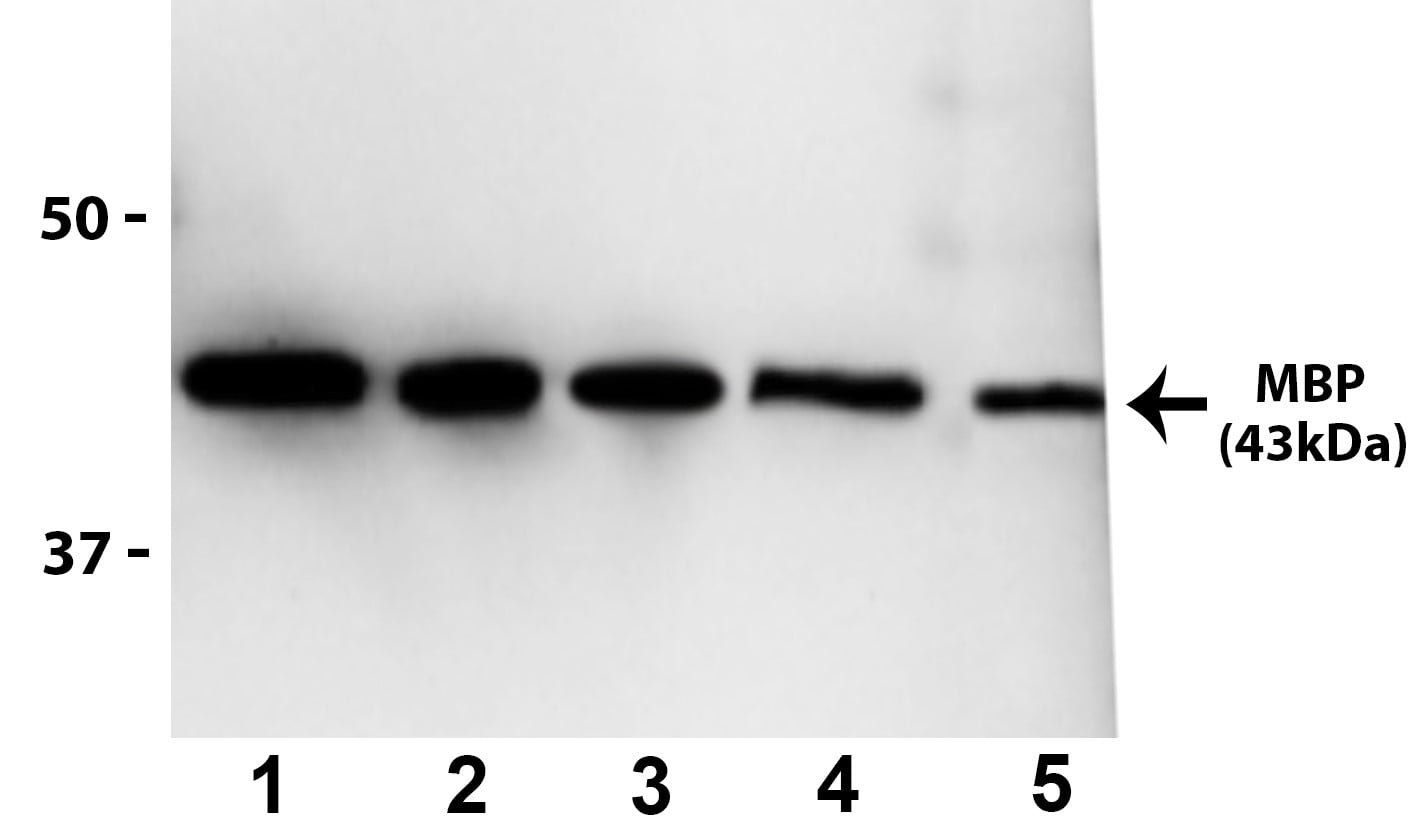 |
| 1:2000 (0.5µg/mL) Ab dilution probed against purified MBP: 50ng (1), 24ng (2), 12ng (3), 6ng (4), and 3ng (5). |
Publications
| pmid | title | authors | citation |
|---|---|---|---|
| We haven't added any publications to our database yet. | |||
Protocols
| relevant to this product |
|---|
| Western blot ICC |
Documents
| # | SDS | Certificate | |
|---|---|---|---|
| Please enter your product and batch number here to retrieve product datasheet, SDS, and QC information. | |||
Only logged in customers who have purchased this product may leave a review.

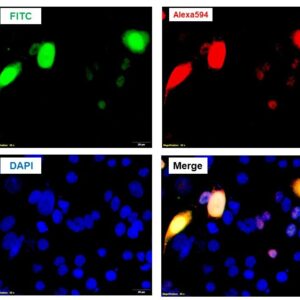
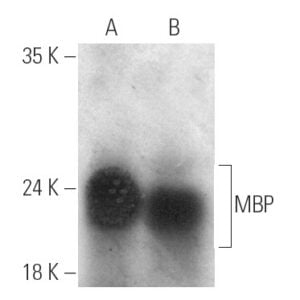
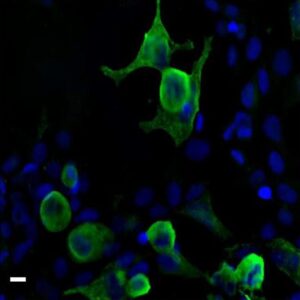
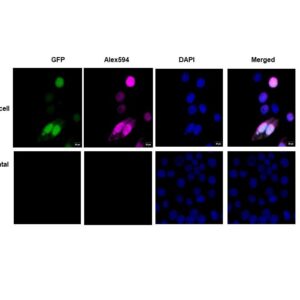
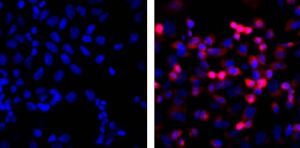
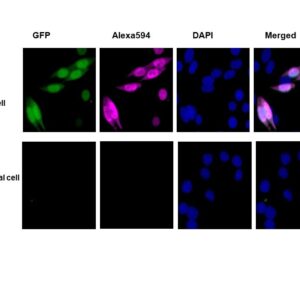
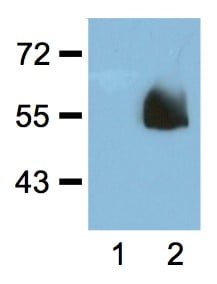
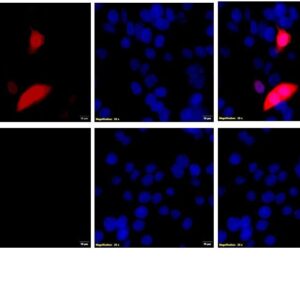
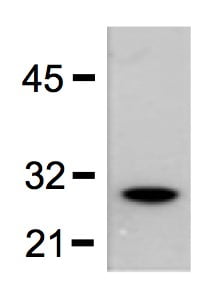
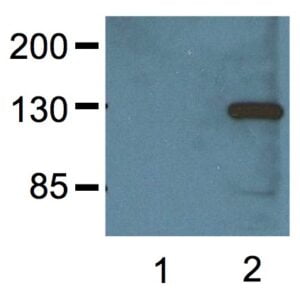

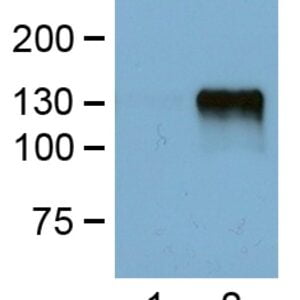


Reviews
There are no reviews yet.